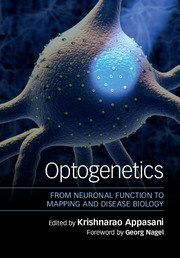Book contents
- OptogeneticsFrom Neuronal Function to Mapping and Disease Biology
- Optogenetics
- Copyright page
- Dedication
- Contents
- Contributors
- Foreword
- Preface
- Part I Optogenetics in Model Organisms
- 1 Introduction to Optogenetics: From Neuronal Function to Mapping and Disease Biology
- 2 Uncovering Key Neurons for Manipulation in Mammals
- 3 From Connectome to Function: Using Optogenetics to Shed Light on the Caenorhabditis elegans Nervous System
- 4 From Synapse to Behavior: Optogenetic Tools for the Investigation of the Caenorhabditis elegans Nervous System
- 5 Using Optogenetics In Vivo to Stimulate Regeneration in Xenopus laevis
- Part II Opsin Biology, Tools, and Technology Platform
- Part III Optogenetics in Neurobiology, Brain Circuits, and Plasticity
- Part IV Optogenetics in Learning, Neuropsychiatric Diseases, and Behavior
- Part V Optogenetics in Vision Restoration and Memory
- Part VI Optogenetics in Sleep, Prosthetics, and Epigenetics of Neurodegenerative Diseases
- Index
- Plate Section (PDF Only)
- References
3 - From Connectome to Function: Using Optogenetics to Shed Light on the Caenorhabditis elegans Nervous System
from Part I - Optogenetics in Model Organisms
Published online by Cambridge University Press: 28 April 2017
- OptogeneticsFrom Neuronal Function to Mapping and Disease Biology
- Optogenetics
- Copyright page
- Dedication
- Contents
- Contributors
- Foreword
- Preface
- Part I Optogenetics in Model Organisms
- 1 Introduction to Optogenetics: From Neuronal Function to Mapping and Disease Biology
- 2 Uncovering Key Neurons for Manipulation in Mammals
- 3 From Connectome to Function: Using Optogenetics to Shed Light on the Caenorhabditis elegans Nervous System
- 4 From Synapse to Behavior: Optogenetic Tools for the Investigation of the Caenorhabditis elegans Nervous System
- 5 Using Optogenetics In Vivo to Stimulate Regeneration in Xenopus laevis
- Part II Opsin Biology, Tools, and Technology Platform
- Part III Optogenetics in Neurobiology, Brain Circuits, and Plasticity
- Part IV Optogenetics in Learning, Neuropsychiatric Diseases, and Behavior
- Part V Optogenetics in Vision Restoration and Memory
- Part VI Optogenetics in Sleep, Prosthetics, and Epigenetics of Neurodegenerative Diseases
- Index
- Plate Section (PDF Only)
- References
- Type
- Chapter
- Information
- OptogeneticsFrom Neuronal Function to Mapping and Disease Biology, pp. 37 - 54Publisher: Cambridge University PressPrint publication year: 2017

